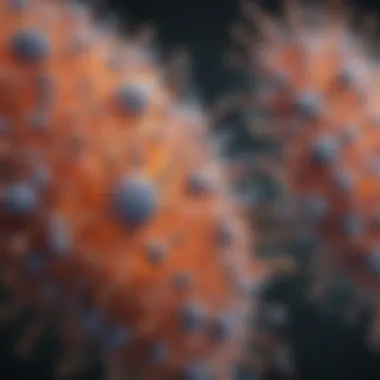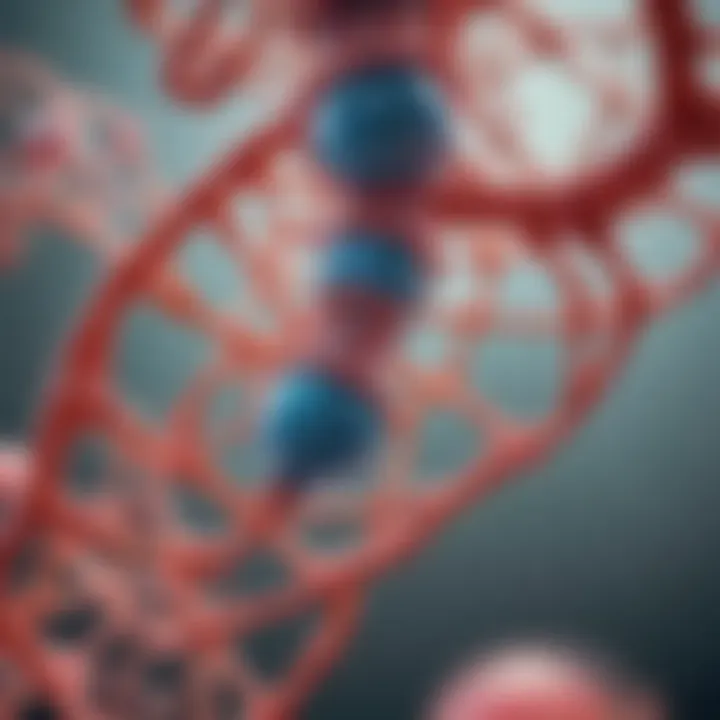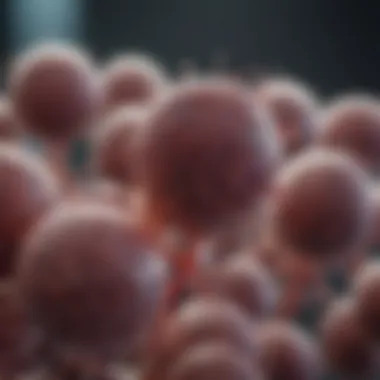Understanding Capping Enzyme: Roles and Implications


Overview of Research Topic
Brief Background and Context
Capping enzymes play a pivotal role in RNA biology, specifically in the stability and translation of messenger RNA (mRNA). The capping process involves the addition of a modified guanine nucleotide to the 5' end of the mRNA molecule. This feature is critical as it not only protects the RNA from degradation but also serves as a recognition point for translation machinery. Understanding these enzymes involves exploring their mechanisms of action and their structural characteristics, which provide insights into their function in cellular processes.
Importance in Current Scientific Landscape
The study of capping enzymes is increasingly important in the context of gene regulation, viral infections, and therapeutic strategies. In recent years, researchers have uncovered the nuanced roles these enzymes play in various biological processes. They influence how genes are expressed and affect cellular responses to viral attacks. The implications for modern medicine are significant, particularly in developing antiviral therapies and understanding cancer biology.
"The role of capping enzymes extends beyond basic RNA biology; they are crucial for understanding complex cellular mechanisms and potential clinical applications."
Methodology
Research Design and Approach
In investigating capping enzymes, various approaches are employed. A combination of biochemical assays, structural biology, and genetic manipulation is often utilized to dissect the function and mechanism of these enzymes. Researchers provide insights into how capping occurs at the molecular level and how changes in these processes can lead to disease states.
Data Collection Techniques
Data is collected through various techniques including:
- In vitro assays to evaluate enzyme activity.
- Cryo-electron microscopy to visualize enzyme structures.
- High-throughput sequencing to analyze the impact of capping on mRNA populations.
- Bioinformatics tools for analyzing large datasets to uncover patterns in gene expression linked to capping enzyme activity.
This multifaceted methodology allows for a thorough understanding of not only how capping enzymes function but also their broader implications in cellular biology.
Preface to Capping Enzyme
Capping enzymes play a fundamental role in RNA biology, impacting mRNA stability and its translation into proteins. This section will clarify the necessity of understanding capping enzymes and their functions. In the context of cellular processes, capping enzymes have substantial implications. They are not merely tools for RNA synthesis; rather, they are integral components that influence gene expression and the regulation of cellular activities.
Understanding capping enzymes opens up avenues for exploring various biological phenomena, such as the mechanisms underlying mRNA interactions and stability. These insights can help clarify how cellular signaling pathways work, especially as they relate to gene expression, disease mechanisms, and potential therapeutic targets.
Definition and Function
Capping enzymes are specialized proteins responsible for adding a chemically distinct structure known as the 5' cap to RNA molecules. This cap consists of a modified guanine nucleotide and plays several critical roles in the life of mRNA.
The primary functions include:
- Protection: The 5' cap serves as a protective barrier against exonucleolytic degradation, ensuring the stability of mRNA.
- Translation Initiation: It facilitates ribosomal recognition, enhancing the efficiency of translation.
- Nuclear Export: The cap structure is vital for the export of mRNA from the nucleus to the cytoplasm, where it is translated into proteins.
In essence, capping enzymes contribute to the overall functionality and longevity of mRNA, crucial for maintaining the integrity of gene expression.
Historical Context
The discovery of capping enzymes stemmed from the broader research into RNA processing and modification. Early studies highlighted the importance of the 5' cap, and subsequent work identified specific enzymes involved in the capping process.
Initially, researchers focused on prokaryotic organisms, discovering the fundamental distinctions between prokaryotic and eukaryotic RNA translation and stability. The identification of capping enzymes occurred in the late 20th century when the biochemical pathways of mRNA maturation began to be unraveled more clearly.
From a historical perspective, the understanding of these enzymes has vastly improved, leading to advancements in molecular biology techniques. Their functions in viral RNA mechanisms further emphasized their relevance. There is also ongoing research aimed at enhancing our understanding of capping enzymes' roles in various diseases and therapeutic strategies.
Understanding this regulatory and functional aspect of RNA biology draws attention to the complexity of gene expression and its implications in numerous fields, including genomics and medicine.
Biochemical Mechanism of Capping
The biochemical mechanism of capping is essential to understand the intricate processes involved in RNA biology. It defines how messenger RNA (mRNA) acquires a protective cap structure. This cap is crucial for mRNA stability, export from the nucleus, and efficiency in translation. Understanding this mechanism reveals the molecular interactions that facilitate these processes, highlighting the relevance of capping enzymes in the overall function and regulation of gene expression.


Enzyme Catalysis Process
The enzyme catalysis process showcases the precise biochemical interactions that occur during the capping of RNA. Capping enzymes, primarily guanylyltransferases, play a pivotal role in this mechanism. They catalyze the transfer of a guanosine monophosphate (GMP) to the 5' end of the RNA molecule, forming a distinctive 5'-5' triphosphate linkage. This reaction not only adds the cap structure but also imparts stability and protects the RNA from degradation.
The efficiency of this enzymatic process is also influenced by the substrate availability and enzyme concentration, making it a finely tuned operation. Any dysfunction in this process can lead to aberrant RNA molecules, resulting in cellular consequences like inefficient translation or even pathogenic events.
Capping Reaction Steps
The capping reaction involves multiple steps, with each step being crucial to the proper formation of the RNA cap.
Triphosphate Addition
Triphosphate addition is the initial step where a triphosphate group is connected to the 5' end of the RNA. This step is significant due to its role in creating a unique cap structure. The triphosphate link ensures that the RNA is recognized correctly by cellular machinery. This characteristic of triphosphate addition makes it a preferred method for RNA capping because it provides a necessary signal for the mRNA to transition into the next stages of processing.
One notable feature of triphosphate addition is its potential to safeguard the RNA molecule from degradation by exonucleases. However, conformational changes in the RNA or the enzyme can affect the triphosphate addition efficiency. In this context, understanding how to optimize this step remains essential in the study of RNA processes.
Cap Methylation
Cap methylation occurs subsequent to the triphosphate addition and involves the addition of a methyl group to the guanosine residue. This step is essential for the cap to achieve full functionality. The methylation of the cap structure helps distinguish self RNA from foreign RNA that may trigger an immune response.
This specific aspect of cap methylation enhances the overall stability of the RNA. Furthermore, it aids in the recruitment of translation initiation factors that recognize the cap structure, facilitating efficient translation. The unique feature of this step is its impact on gene expression regulation. However, like triphosphate addition, the efficiency of cap methylation can be influenced by various factors. Abnormal cap methylation patterns can lead to diseases, thus making it a critical area of research in therapeutic applications.
Structural Biology of Capping Enzymes
The structural biology of capping enzymes plays a crucial role in understanding their function and importance in RNA biology. By exploring the specific elements of enzyme architecture, we gain insights into how these proteins perform their roles and interact with other biomolecules. Structural studies reveal information about the spatial arrangement of atoms within the enzymes, providing key details on how they catalyze the capping process. The implications of structural understanding extend beyond basic biology, impacting therapeutic developments and our knowledge of disease mechanisms.
Capping Enzyme Structure
Capping enzymes exhibit diverse structures tailored to their specific function in attaching a cap to the 5’ end of RNA. Most capping enzymes are characterized by conserved domains, such as the RNA 5'-triphosphate hydrolase domain, which is essential for recognizing and processing the triphosphate moiety of RNA precursors. Other structural features may include regions that facilitate protein-protein interactions, which are vital for assembling the capping complex.
Key structural characteristics include:
- Nucleotide Binding Sites: These sites are crucial for the enzyme's ability to bind to RNA substrates and catalyze the transfer of the cap structure.
- Catalytic Residues: Specific amino acids within these enzymes act as catalytic residues, allowing them to perform their enzymatic functions efficiently. These residues are often evolutionarily conserved, signifying their importance in the enzymatic activity.
- Overall Conformation: The three-dimensional shape of capping enzymes can influence their activity and interaction with other molecules. Structural changes may occur in response to substrate binding, indicating a dynamic mechanism of action.
The structural insights into capping enzymes enhance our understanding of how these molecules drive critical processes in RNA metabolism.
Molecular Interactions in Capping
Capping enzymes do not operate in isolation; their functionality greatly depends on various molecular interactions with RNA substrates and other proteins. Understanding these interactions provides a more comprehensive view of how capping enzymes contribute to RNA biology.
Interactions can be categorized as follows:
- RNA-Protein Interactions: The binding between RNA and capping enzymes is finely tuned. Enzyme specificity for RNA sequences and structures can dictate capping efficiency and precision.
- Protein-Protein Interactions: Capping enzymes often collaborate with other enzymes and factors in multi-protein complexes. These interactions facilitate a coordinated approach to mRNA processing, ensuring the timely addition of the cap structure.
- Signaling Pathway Engagement: Capping enzymes can be involved in signaling cascades through interactions with cellular factors. This can lead to regulation of gene expression and modulate responses to environmental changes.
The study of molecular interactions adds another layer of complexity to our understanding of capping enzymes, highlighting the network of relationships essential for effective RNA processing.
"Understanding the structure and molecular interactions of capping enzymes provides essential insights that can drive future research towards novel therapeutic strategies."
Importance of RNA Capping
RNA capping plays a crucial role in the lifecycle of mRNA and has extensive implications in cellular biology. Capping involves adding a modified guanine nucleotide to the 5' end of mRNA transcripts, known as the 7-methylguanylate cap. This modification stabilizes mRNA and is essential for proper functioning and utilization within the cell.
The importance of RNA capping can be understood through various facets:
- Protection: The capping mechanism shields mRNA from degradation by exonucleases, which are enzymes that degrade RNA from its ends. The cap structure acts as a protective barrier, enhancing the stability of mRNA molecules in the cytoplasm.
- Facilitation of Translation: The cap is recognized by the ribosomes, which initiate translation. It plays a key role in the recruitment of translation factors, ensuring the efficient synthesis of proteins. Without a proper cap, mRNA would not be effectively translated, leading to decreased protein synthesis.
- Influencing Splicing: Capping also influences RNA splicing, the process where non-coding regions are removed from pre-mRNA. The presence of a cap can affect the splicing machinery, enhancing the accuracy of removing introns.
In summary, RNA capping is not merely a modification; it is a vital process that impacts mRNA stability and translation efficiency. Through these mechanisms, capping connects directly to the overall regulation of gene expression, which is essential for cellular health and function.


Role in mRNA Stability
The stability of mRNA is paramount for gene expression regulation. Without stability, specific mRNA transcripts would degrade rapidly, leading to cellular imbalances. RNA capping contributes significantly to this stability. The 7-methylguanylate cap protects the mRNA molecule from enzymatic attacks from exonucleases.
In addition to protecting mRNA, the cap structure also promotes the formation of a closed-loop structure. This circularization further enhances the interaction between the mRNA and the ribosome, facilitating efficient translation. Consequently, when mRNA is capped, it is less susceptible to degradation, which results in a longer half-life in the cell. Researchers have observed that capped mRNA consistently survives longer than non-capped counterparts under similar conditions, highlighting the cap's protective role.
Impact on Translation Efficiency
The presence of a proper cap structure directly influences translation efficiency. The binding of translation initiation factors, such as eIF4E and eIF4G, to the cap is a critical step in the translation initiation process. These factors are necessary for the recruitment of the ribosomal subunits, allowing for protein synthesis to commence.
Moreover, studies indicate that the absence of a cap results in significant reductions in translation. Capped mRNAs often undergo more rapid initiation of translation when compared to uncapped RNAs. This observation has crucial implications for understanding how genetic information is processed within cells. Additionally, the interaction between the cap and the ribosome facilitates the recycling of ribosomal subunits, enhancing overall translational efficiency.
Capping Enzyme in Cellular Processes
Capping enzymes play a crucial role in various cellular processes, particularly in gene expression and signaling mechanisms. They are essential for the post-transcriptional modification of RNA molecules, significantly impacting how genetic information is utilized. The capping process plays a pivotal role in protecting RNA from degradation, promoting ribosome recognition, and enhancing the overall stability of mRNA. Understanding these processes enables researchers to comprehend the complex dynamics of cellular functions that rely on accurate gene expression regulation.
Gene Expression Regulation
The regulation of gene expression is a central theme in molecular biology, impacting cellular function and organism development. Capping enzymes directly influence gene expression by modifying RNA molecules, specifically mRNA. The cap structure, added to the 5’ end of mRNA, acts as a protective barrier against exonuclease degradation. This stability is vital, as mRNA must last long enough to be translated into proteins.
Furthermore, capping facilitates the efficient initiation of translation. Eukaryotic ribosomes recognize the cap structure, which is essential for binding during the translation process. This mechanism is crucial as it ensures that the correct protein is produced, following the specific code encoded by the organism's DNA.
Research has shown that disruptions in capping enzyme activity can lead to significant consequences, such as inefficient protein synthesis or the degradation of important mRNA types. Such disruptions can contribute to various diseases, emphasizing the importance of capping enzymes in maintaining proper gene expression control.
Cellular Signaling Pathways
Capping enzymes also play a vital role in cellular signaling pathways. These pathways are essential for the communication between cells and their environment, influencing cellular responses and behavior. Capping affects not only the stability of mRNA but also the release and translation of key signaling molecules.
The cap structure on RNA has been associated with increased efficacy of cellular signaling. For instance, mRNAs encoding for growth factors or cytokines often have distinct capping which enhances their stability and, consequently, their availability for translation. This availability can dictate cellular responses to environmental factors, allowing for adaptability and survival in changing conditions.
In summary, the interaction between capping enzymes and cellular processes underscores their fundamental importance in gene expression and signaling. As researchers delve deeper into these mechanisms, they uncover potential pathways to therapeutic interventions that can harness or rectify deregulated processes, showcasing the expansive implications of these enzymatic activities in health and disease.
Capping Enzymes and Viral Mechanisms
Capping enzymes play a crucial role in the interaction between viral pathogens and their host cells. Understanding these mechanisms is vital for both identifying potential therapeutic targets and developing effective antiviral strategies. By manipulating the capping process, viruses can enhance their stability and facilitate translation, allowing for an efficient replication cycle. This highlights the dual nature of capping enzymes as both fundamental to cellular function and as a means for viral exploitation.
Viral RNA Capping Strategies
Viruses employ various strategies for RNA capping to ensure the successful translation of their genetic material. These strategies typically fall into two categories based on whether the virus utilizes the host's capping machinery or employs its own unique mechanisms.
- Utilizing Host Machinery: Some viruses leverage the host’s capping enzymes to add a cap structure to their RNA. This approach helps the viral RNA evade detection by the host immune system and ensures that the viral mRNA is properly processed. For example, Influenza viruses depend on cellular enzymes for capping their transcripts.
- Viral Specific Mechanisms: Other viruses, particularly those with RNA genomes, have developed unique capping strategies. For instance, the Hepatitis C virus encodes its own capping enzyme, allowing it to efficiently produce capped RNA without relying on the host's biological machinery. This independence not only streamlines the capping process but can also render the host’s defenses less effective.
These capping strategies play a significant role in the overall virulence and adaptability of viruses, making them an important focus of research.
Host Cell Interactions
The interaction between capping enzymes and host cells can determine the outcome of viral infections. Understanding these interactions is critical for better therapeutic interventions.
- Immune Evasion: Many viruses can modify the capping process to evade the host's immune response. A properly capped RNA signals the host that it is a legitimate message, preventing activation of the innate immune defense.
- Translation Facilitation: Capped RNA facilitates efficient translation by ribosomes. This means that viruses can quickly produce their proteins, which is essential for effective replication and infection.
- Manipulation of Host Pathways: Some viruses can manipulate host signaling pathways, promoting an environment conducive to their replication. They may alter the expression of host capping enzymes. This manipulation can enhance the stability of their own transcripts while suppressing the host’s immune responses.
"The ability of viruses to hijack or influence capping enzymatic machinery represents a sophisticated level of adaptation and can lead to significant implications for viral pathogenesis."
In summary, the dynamics between viral capping strategies and host cell interactions emphasize the importance of capping enzymes in understanding viral mechanisms. Addressing these interactions may open avenues for antiviral drug development and therapeutic interventions.
Therapeutic Implications of Capping Enzymes
The therapeutic implications of capping enzymes have gained growing attention in recent years due to their crucial roles in various biological processes. Given that capping enzymes are essential for the proper functioning of mRNA, the therapeutic exploration of these enzymes can yield significant benefits in the fields of medicine and biotechnology. By understanding their mechanisms, researchers can identify opportunities for therapeutic interventions in diseases where capping enzyme functionality is disrupted.


Potential Drug Targets
Capping enzymes present intriguing opportunities for drug development. They can serve as potential drug targets for several reasons. First, their specific activity in RNA processing makes them critical in various cellular functions. Inhibiting capping enzymes can lead to decreased viral replication, as many viruses rely on these enzymes for their RNA synthesis. For instance, the inhibition of the capping enzyme from the influenza virus has shown promise in reducing viral loads in vitro.
Moreover, the modulation of capping enzyme activity could have implications in cancer therapies. Some types of cancer exhibit changes in RNA stability and translation efficiency, often linked to aberrations in capping processes. By targeting these enzymes, researchers could potentially restore normal mRNA function, thus reducing malignant properties in cancer cells.
The specificity of capping enzymes also allows for the possibility of developing small-molecule inhibitors that can selectively interfere with their functionality. This could minimize off-target effects common with broader-spectrum antiviral and anticancer drugs, enhancing their safety profiles.
Gene Therapy Applications
The application of capping enzymes extends into gene therapy. In gene therapy, ensuring the stability and proper expression of therapeutic genes is paramount. Capping enzymes are involved in the capping of mRNA that encodes therapeutic proteins. By enhancing the capping efficiency, researchers can improve the stability and translational efficacy of the mRNA delivered to target cells.
One strategy involves the engineering of capping enzymes to create modified mRNA that is more effective in eliciting a desired biological response. For instance, using synthetic capping structures has been effective in improving the expression levels of mRNA in various therapeutic settings. Additionally, this can be crucial for the development of mRNA vaccines, where the stability of the mRNA is necessary for effective immune responses.
"Optimizing capping processes is essential for maximizing mRNA therapeutic efficacy."
Furthermore, capping enzymes can facilitate the development of novel therapeutic modalities, including personalized medicine approaches. In patients with particular genetic mutations affecting capping machinery, targeted therapies that enhance or compensate for these defects could represent groundbreaking advancements in treatment plans.
In summary, the therapeutic implications of capping enzymes are profound. By targeting these enzymes as potential drug candidates and leveraging their properties for gene therapies, researchers can capitalize on their roles in RNA biology to develop innovative solutions for current medical challenges.
Current Research Trends
The study of capping enzymes has seen significant growth in recent years. Researchers are increasingly focused on how these enzymes impact RNA biology, particularly in the context of mRNA stability and translation efficiency. Understanding current research trends is crucial for grasping how developments in this field may affect future therapeutic approaches and basic biological understanding. This exploration not only sheds light on the fundamental biology of capping enzymes but also their roles in various diseases, including viral infections and cancer.
Recent Discoveries
Recent studies have unveiled important insights into the structural and functional properties of capping enzymes. For instance, new crystallographic data has shown specific conformational changes in these enzymes that correlate with their activity. This knowledge can inform the understanding of their catalytic mechanisms and can lead to the identification of new drug targets. Moreover, findings have emerged that indicate how certain mutations in capping enzymes might render cells more susceptible to viral infections, highlighting the evolutionary arms race between viruses and their hosts.
- Key Points in Recent Discoveries:
- Understanding structural changes in capping enzymes.
- Identification of new drug targets within RNA biology.
- The role of capping enzyme mutations in viral susceptibility.
These discoveries underpin the importance of basic research in unveiling the complexities of capping enzymes. They pave the way for innovative interventions in treating diseases linked to dysfunctional RNA capping.
Future Research Directions
Looking ahead, several potential research avenues present themselves. Scientists are seeking to understand how capping enzymes interact with other RNA-binding proteins during mRNA maturation. Further research on the regulation of these enzymes could also yield insights into cellular signaling pathways, potentially leading to new therapeutic strategies.
- Promising Future Directions:
- Investigating interactions between capping enzymes and RNA-binding proteins.
- Studying the regulation of capping enzymes in various cellular contexts.
- Exploring the implications of capping enzyme function in diseases like cancer and viral infections.
These future explorations are essential to unraveling the complexities of RNA biology. They hold promise not only for advancing scientific knowledge but also for translating that knowledge into clinical solutions.
Closure and Perspectives
In summary, the exploration of capping enzymes is essential for understanding their multifaceted role in RNA biology. This section wraps up the key insights from the discussion, offering clarity on their significance in various biological contexts. The nuances of these enzymes not only contribute to mRNA stability and translation efficacy but also play pivotal roles in gene regulation and cellular signaling. Recognizing the vital functions of capping enzymes serves as a foundation for future studies and therapeutic innovations.
Summary of Key Insights
Capping enzymes facilitate the addition of a 7-methylguanylate cap to the 5' end of eukaryotic mRNA. This modification is crucial for several reasons:
- Enhances mRNA Stability: The cap protects mRNA from degradation.
- Facilitates Translation Initiation: The cap is recognized by translation machinery.
- Regulates Gene Expression: It influences how mRNA is processed and exported from the nucleus.
- Viral Interaction: Many viruses hijack the capping process to evade host defenses.
These insights highlight the integral nature of capping enzymes in maintaining RNA integrity and function, emphasizing their role as targets for therapeutic interventions and research initiatives.
Finales on Biological Significance
Understanding capping enzymes carries profound implications for biology and medicine. Their roles extend beyond basic cellular functions, influencing diverse processes like viral pathogenicity and cellular responses to stress.
- Therapeutic Potential: Inhibitors of capping enzymes could serve as antiviral drugs, providing a novel strategy against certain viruses.
- Gene Therapy: Enhancing capping efficiency may improve the outcomes of gene therapy approaches by ensuring more stable and functional mRNA.
The ongoing investigation into these enzymes will likely unveil further complexities of RNA biology. Such knowledge could pave the way for novel therapeutic avenues, impacting treatments for a variety of diseases, including cancers and genetic disorders.



